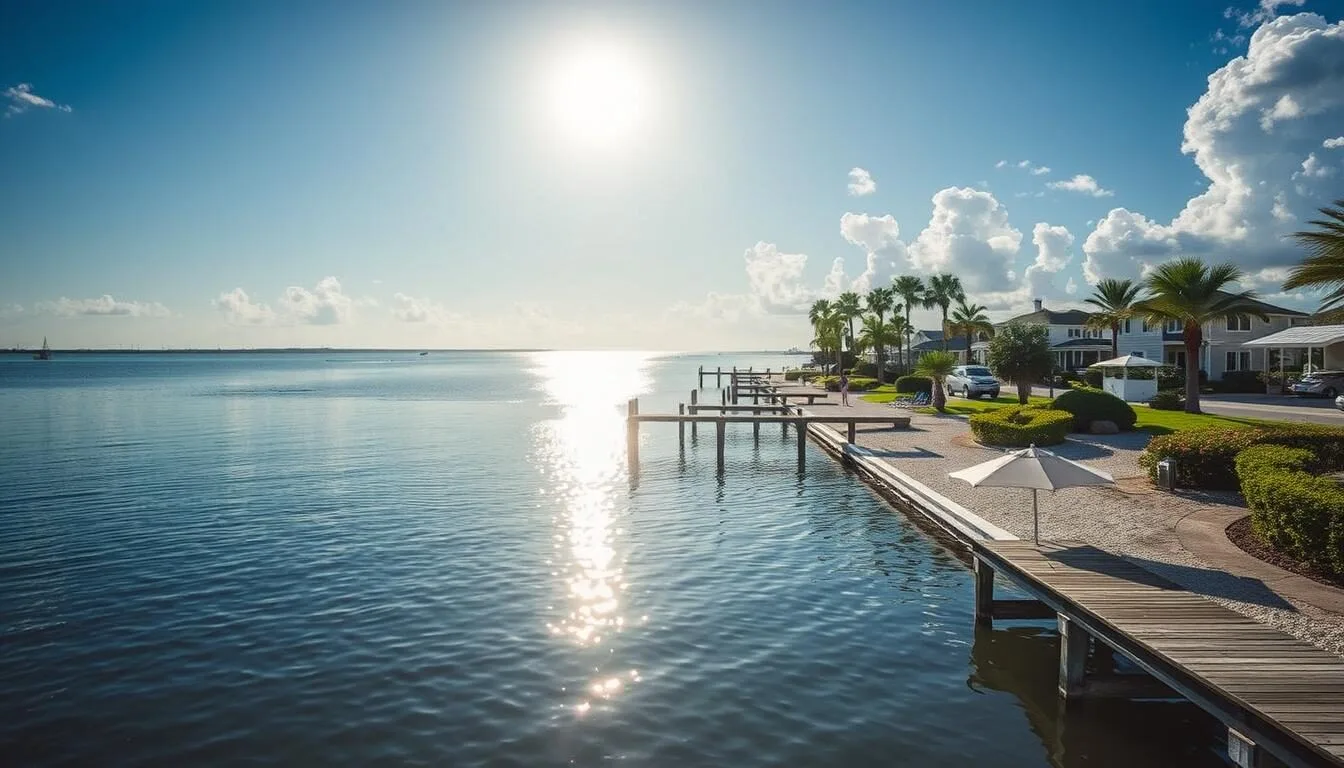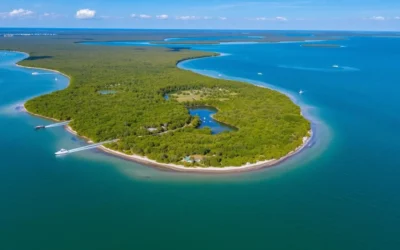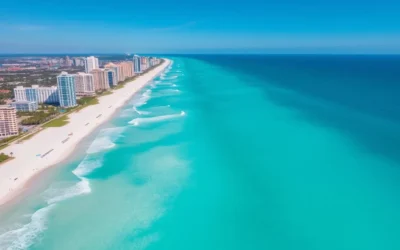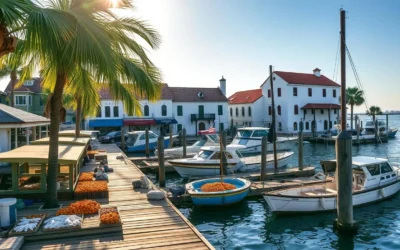Understanding the Importance of Timing in Cape Coral
With its subtropical climate, Cape Coral offers a unique blend of weather conditions throughout the year, making some months more ideal for visiting than others.
The city’s weather patterns vary significantly across different seasons, impacting the quality of your vacation. Understanding these patterns is crucial for planning a weather-savvy trip.
Cape Coral’s temperature typically ranges from 56°F to 91°F, rarely dipping below 44°F or rising above 94°F. This temperature range indicates a relatively mild climate, suitable for various activities throughout the year.
Based on the tourism score, which considers factors like temperature, cloud cover, and precipitation, the best times to visit Cape Coral for warm-weather activities are from late January to early May and from late October to late December.
Key Considerations for Your Trip:
- You’ll discover why timing is crucial when planning your trip to Cape Coral, Florida, as the city experiences distinct seasonal weather patterns throughout the year.
- Understanding Cape Coral’s unique climate will help you choose the perfect months for your visit, whether you’re seeking warm beach days or comfortable sightseeing weather.
- This comprehensive guide breaks down Cape Coral’s weather by season, giving you month-by-month insights into temperatures, precipitation, humidity, and more.
- You’ll learn about the best times to visit based on tourism scores and beach/pool scores, which consider factors like temperature, cloud cover, and precipitation.
- By the end of this guide, you’ll be equipped with all the weather knowledge needed to plan a perfect Cape Coral getaway tailored to your preferences.
Understanding Cape Coral’s Unique Climate
The city’s climate is characterized by its subtropical location and surrounding water bodies. This unique combination significantly influences the weather patterns you experience during your visit.
Geographical Influences on Weather Patterns
Cape Coral’s geography plays a crucial role in shaping its climate. The city’s proximity to the Gulf of Mexico and its extensive network of waterways moderate temperatures, maintaining a relatively warm climate throughout the year. The surrounding waters absorb and release heat slowly, regulating temperature fluctuations and contributing to the area’s mild winters and warm summers.
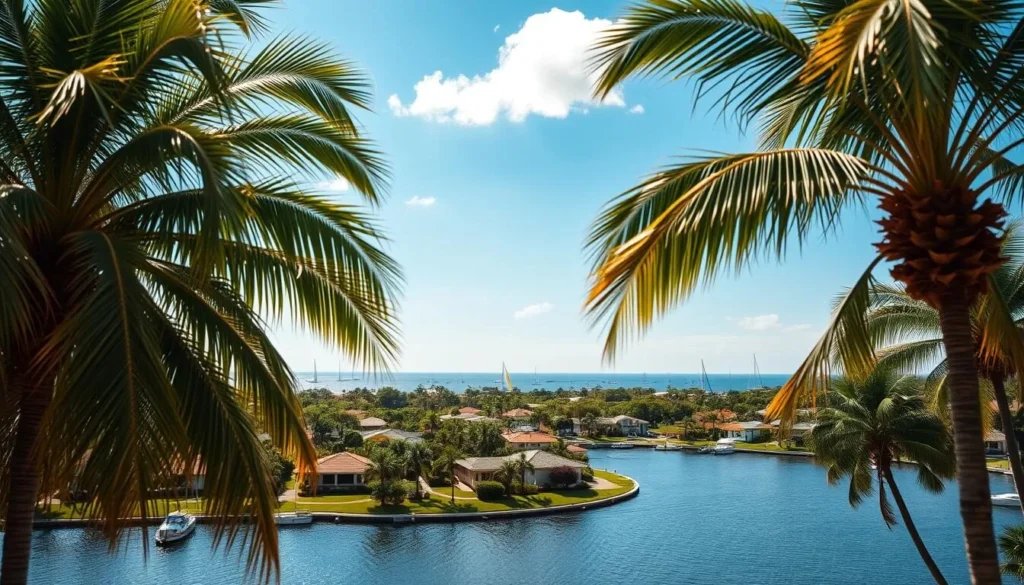
Year-Round Climate Overview
Over the course of the year, the temperature typically varies from 56°F to 91°F and is rarely below 44°F or above 94°F. You can expect:
- A wide range of temperatures throughout the year, from mild winters to hot, humid summers.
- A relatively warm climate year-round, with January being the coolest month, still maintaining a comfortable average temperature.
- Distinct wet and dry periods, with the wet season running from May through October.
- Cape Coral to be accessible in every month, though your comfort level may vary based on your tolerance for heat and humidity.
Understanding the typical weather for each month will help you plan activities that align with the conditions during your visit, ensuring a more enjoyable trip.
Cape Coral, Florida: Best Months for a Weather-Savvy Trip
To make the most of your trip to Cape Coral, it’s essential to identify the best months for comfortable weather and enjoyable activities. Understanding the local climate and weather patterns can significantly enhance your travel experience.
Tourism Score: When to Visit for Comfortable Weather
The tourism score is a valuable tool for determining the best time to visit Cape Coral for comfortable weather conditions. It takes into account factors like temperature, cloud cover, and precipitation. Generally, the period from late spring to early fall is considered ideal due to the pleasant average daily temperatures and lower rainfall.
During this optimal period, you can enjoy outdoor activities without the discomfort of extreme heat or cold. The tourism score peaks during the months when the weather is most conducive to sightseeing and outdoor exploration.
Beach/Pool Score: Optimal Times for Water Activities
The beach/pool score is particularly useful for identifying the best times for water activities in Cape Coral. It favors clear, rainless days with perceived temperatures between 75°F and 90°F. Based on this score, the best times to visit for hot-weather activities are from mid-April to late May and from early October to early November.
- The best combination of warm temperatures and lower rainfall for beach and pool enjoyment is found in late spring (April-May) and early fall (October).
- During these periods, you can expect average daily temperatures that are warm enough for swimming but not so hot that outdoor activities become uncomfortable.
- The summer months from May to October offer the warmest water temperatures, but they come with higher humidity and more frequent afternoon thunderstorms.
Winter in Cape Coral: December to February
Cape Coral’s winter season, spanning from December to February, offers ideal conditions for exploring the city’s natural beauty. You can enjoy the comfortable weather and abundant sunshine, making it perfect for outdoor activities.
Temperature and Precipitation Expectations
During the winter months, Cape Coral experiences mild temperatures, with average highs around 75°F (24°C) and lows around 50°F (10°C). The clearest month of the year is February, with the sky being clear, mostly clear, or partly cloudy 67% of the time. You can expect minimal rainfall during this period, making it an excellent time for outdoor exploration.
| Month | Average High Temperature | Average Low Temperature |
|---|---|---|
| December | 73°F (23°C) | 52°F (11°C) |
| January | 74°F (23°C) | 51°F (11°C) |
| February | 75°F (24°C) | 53°F (12°C) |
Winter Activities and Attractions
Winter in Cape Coral brings a variety of seasonal events and activities that take advantage of the pleasant weather. You can enjoy art festivals, boat shows, and outdoor concerts, or explore the city’s numerous parks, nature preserves, and waterways. According to tourism sources, winter offers some of the most comfortable weather for golfing, fishing, boating, and wildlife viewing in Cape Coral’s natural areas.
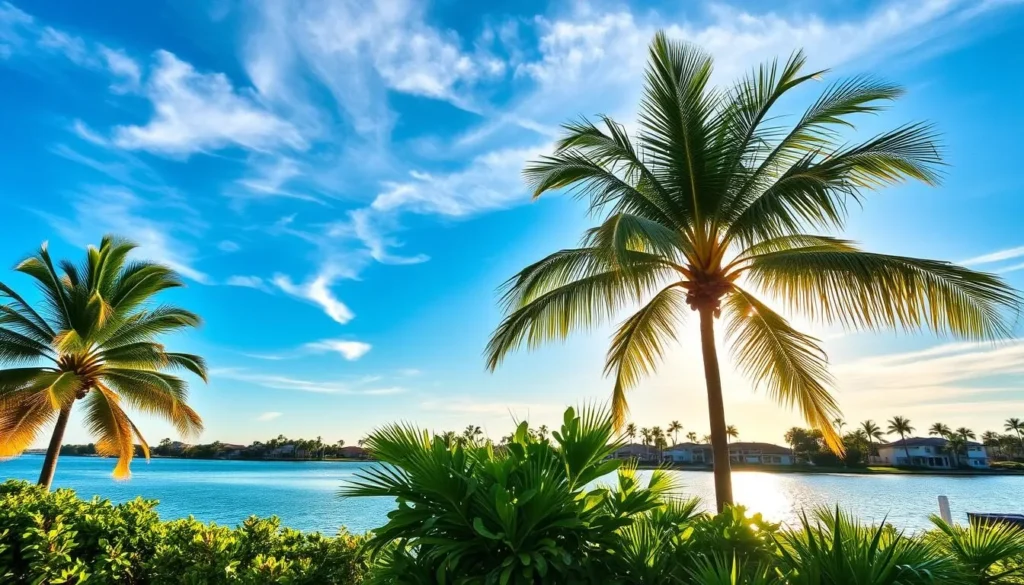
- Explore Cape Coral’s numerous parks and nature preserves without the summer heat and humidity.
- Enjoy the highest number of sunny days in February, perfect for outdoor enjoyment.
- Take part in seasonal events like art festivals, boat shows, and outdoor concerts.
Spring in Cape Coral: March to May
As winter fades, Cape Coral welcomes the warmth of spring, making March to May an ideal time to visit. During this period, the weather transitions into a more comfortable state, perfect for outdoor activities and enjoying the city’s attractions.
Weather Transitions and Patterns
The spring season brings a significant change in weather patterns. You’ll experience comfortable temperatures ranging from the 70s°F to the low 80s°F, ideal for outdoor activities. The weather during spring is characterized by mild days and cooler nights, making it an excellent time to enjoy Cape Coral’s beaches and parks.
As the season progresses, the days get longer, providing more daylight to explore the city’s waterways and outdoor recreational facilities. Spring is also a great month to enjoy the various festivals and outdoor events that Florida is known for.
Spring Break Considerations and Activities
Spring break is a significant period in Cape Coral, attracting many visitors, especially in March when schools and colleges have their breaks. If you’re planning a visit during this time, expect larger crowds and higher occupancy rates at accommodations. It’s advisable to book your stay well in advance to avoid any inconvenience.
- The comfortable weather during spring break makes it an ideal period for water sports and activities.
- With warming temperatures, you can enjoy swimming and other water activities without the extreme heat of the summer months.
- The extended daylight hours give you more time to enjoy the city’s attractions and outdoor spaces.
| Month | Average High Temperature | Average Low Temperature |
|---|---|---|
| March | 78°F | 62°F |
| April | 82°F | 66°F |
| May | 86°F | 70°F |
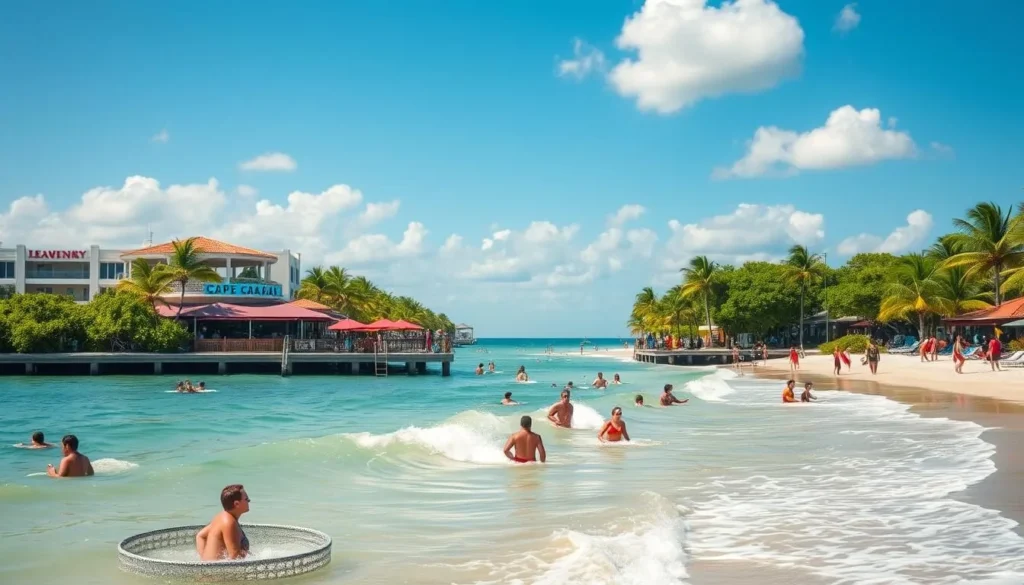
Planning a year visit during spring break requires early preparation, including booking your accommodations and planning activities around the events and festivals happening during your stay.
Summer in Cape Coral: June to August
If you’re planning a trip to Cape Coral during the summer, you’re in for a treat with its warm climate. Summer is a peak season for beachgoers and water sports enthusiasts.
Heat, Humidity, and Afternoon Thunderstorms
Summer in Cape Coral is characterized by high temperatures and humidity. The average temperature during these months is warm, making it ideal for beach activities. However, it’s also a time when afternoon thunderstorms are common.
Weather Conditions: The summer months bring warm weather, with average highs often reaching the mid-80s to low 90s Fahrenheit. The heat index, which takes into account both temperature and humidity, can make it feel even hotter.
| Month | Average High Temperature (°F) | Average Precipitation (inches) |
|---|---|---|
| June | 89 | 6.2 |
| July | 90 | 7.1 |
| August | 90 | 7.5 |
Summer Water Activities and Beach Conditions
The warm waters of the Gulf of Mexico make Cape Coral an ideal destination for swimming, snorkeling, and paddleboarding during the summer. The average water temperature in August, the warmest month, reaches 86°F, making it exceptionally comfortable for water activities.
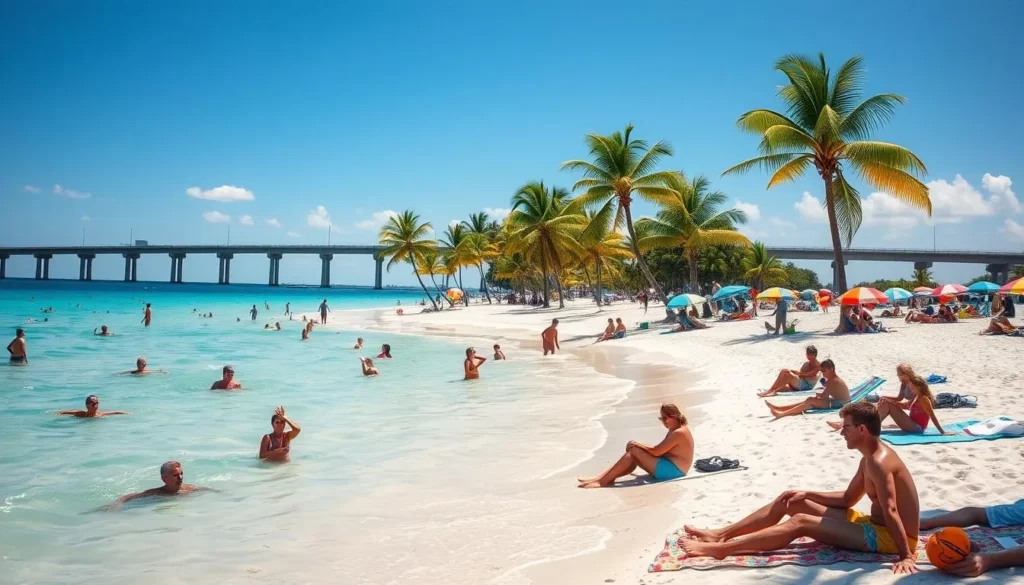
To make the most of your beach trip, consider visiting during the early morning or evening hours when the sun is not too intense. The Gulf waters around Cape Coral offer ideal conditions for various water sports, with the water temperature remaining warm throughout the summer.
- The water temperature is consistently above 82°F from June to October.
- August is the peak month for warm water, averaging 86°F.
- Beach activities are best enjoyed during the cooler parts of the day.
Fall in Cape Coral: September to November
Fall in Cape Coral brings a welcome relief from the summer swelter, offering pleasant weather and exciting events. As the summer months come to a close, the city transitions into a more comfortable climate, making it an ideal time to visit.
Weather Patterns
During the fall months, Cape Coral experiences a significant shift in weather patterns. The temperatures become milder, and the humidity decreases, creating comfortable weather conditions. By late October, the weather has improved significantly, making it perfect for outdoor activities.
| Month | Average High Temperature | Average Precipitation |
|---|---|---|
| September | 88°F | 6.2 inches |
| October | 84°F | 3.5 inches |
| November | 78°F | 2.3 inches |
Fall Events and Attractions
The fall season in Cape Coral is filled with a variety of events and attractions. You can enjoy harvest festivals, Halloween celebrations, and Thanksgiving-themed activities. These events take place throughout the city, offering something for everyone. The improving weather conditions from late October through November create perfect opportunities for outdoor festivals and community events.
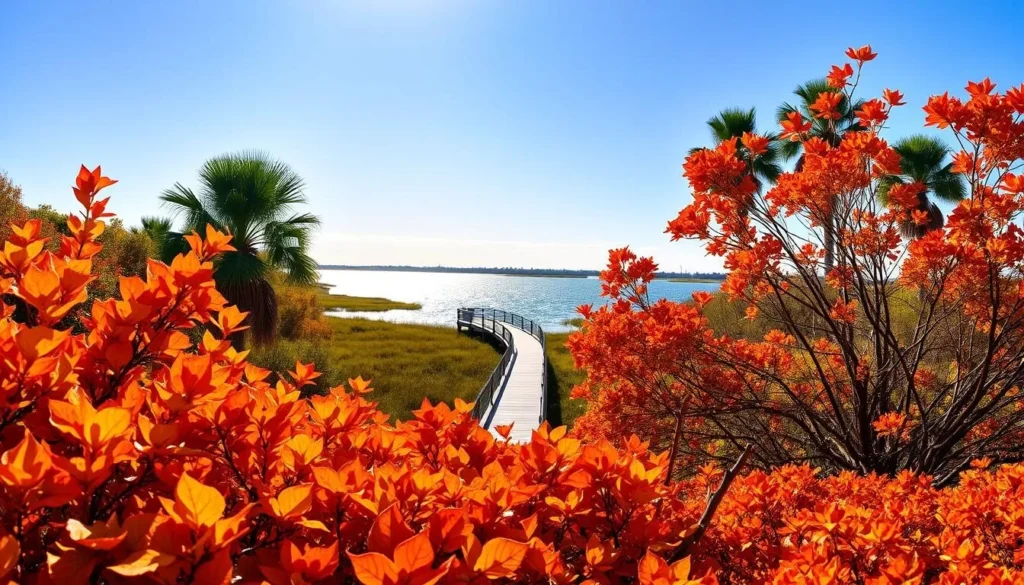
During the fall, you’ll find that the comfortable weather days are ideal for exploring Cape Coral’s parks, nature preserves, and waterways. It’s one of the best times of year to enjoy outdoor dining in the city, with pleasant evening temperatures and decreasing insect activity.
Temperature Variations Throughout the Year
Understanding the temperature fluctuations throughout the year is crucial for planning a trip to Cape Coral. The city’s subtropical climate means that temperatures vary significantly from season to season, impacting the comfort and enjoyment of outdoor activities.
Average High and Low Temperatures by Month
Cape Coral’s temperature ranges from a cool average low of 50°F in January, the coolest month, to a high of around 90°F in July and August, the warmest months. The average high and low temperatures by month are as follows:
| Month | Average High (°F) | Average Low (°F) |
|---|---|---|
| January | 75 | 50 |
| February | 77 | 52 |
| March | 80 | 58 |
| April | 84 | 62 |
| May | 88 | 68 |
| June | 90 | 73 |
| July | 91 | 74 |
| August | 91 | 74 |
| September | 89 | 72 |
| October | 85 | 66 |
| November | 81 | 60 |
| December | 77 | 54 |
Comfortable Temperature Days Analysis
The number of days per year with comfortable weather is calculated based on daily high temperatures between 65°F and 86°F, daily maximum dew point temperatures less than or equal to 65°F, average daily cloud cover less than or equal to 65%, and average daily wind speed less than or equal to 18 mph.
Cape Coral experiences a significant number of comfortable weather days throughout the year, particularly during the winter and early spring months. The highest concentration of comfortable temperature days is from December through April, when daily high readings typically fall between 70-85°F with lower humidity.
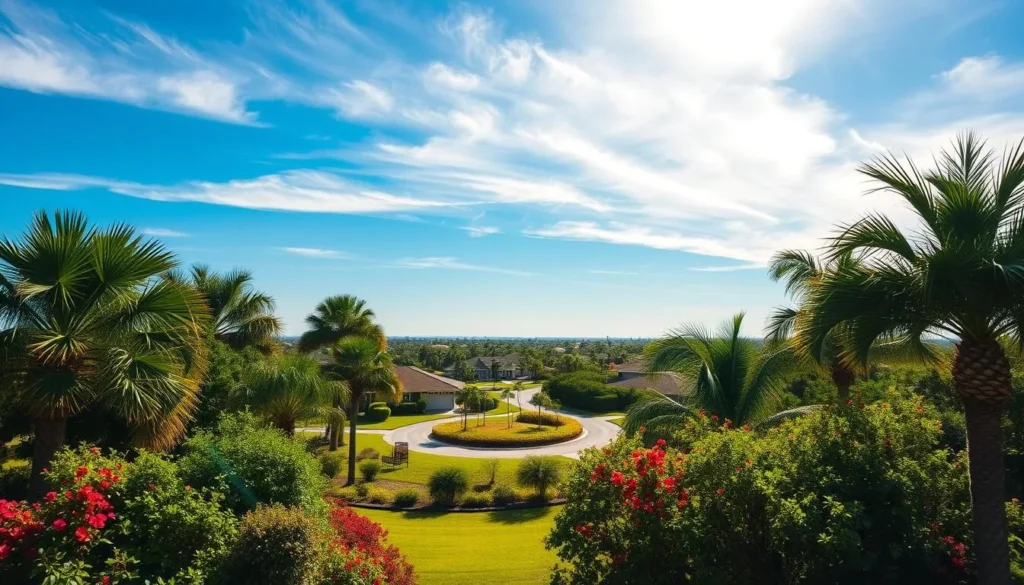
Rainfall and Precipitation Patterns
To plan your trip effectively, it’s essential to know Cape Coral’s rainfall and precipitation patterns. The city’s weather is characterized by a distinct wet and dry season, significantly impacting the average monthly rainfall.
Wet Season vs. Dry Season
Cape Coral experiences a dramatic variation in rainfall throughout the year, with summer months receiving three to four times more precipitation than winter months. According to weather sources, the annual rainfall averages around 53 inches, with over half of that falling during the summer wet season. The wet season, which includes months like August, typically receives the most rain, with an average of 5.9 inches.
Monthly Rainfall Averages
The city‘s average monthly rainfall pattern shows a sharp increase beginning in May and continuing through September before declining rapidly in October. Here’s a breakdown of the average rainfall in inches per month: January (1.7), February (1.8), March (2.0), April (1.8), May (2.6), June (5.7), July (5.7), August (5.9), September (5.4), October (2.6), November (1.5), and December (1.3). You’ll notice that the summer months have significantly more rainfall, often coming in short, intense afternoon thunderstorms rather than prolonged rainy periods.

Humidity and Cloud Cover Considerations
When planning a trip to Cape Coral, understanding the humidity and cloud cover is crucial for a comfortable experience. Cape Coral experiences a distinct pattern of clear and cloudy months throughout the year.
Muggy Periods and Comfort Levels
The muggy period in Cape Coral lasts for several months, impacting comfort levels during this time. You’ll find that the summer months are particularly humid, with significantly higher levels of mugginess.
Clear vs. Cloudy Months
The clearer part of the year in Cape Coral begins around October 9 and lasts for 7.6 months, ending around May 29. The clearest month is February, with clear or mostly clear skies approximately 67% of the time. In contrast, the cloudiest month is August, with cloudy or mostly cloudy conditions about 67% of the time. The transition to clearer weather begins in late October, creating excellent conditions for outdoor activities and stargazing.

- Cape Coral’s winter months offer the clearest skies, making it ideal for outdoor activities.
- February provides the clearest conditions, with clear or mostly clear skies approximately 67% of the time.
- Summer months, particularly August, feature significantly more cloud cover.
Hurricane Season: What Travelers Should Know
When planning a trip to Cape Coral, Florida, it’s crucial to be aware of hurricane season. This period can significantly impact your travel plans, and being informed is key to a stress-free vacation.
Hurricane Season Timeline and Risks
Hurricane season in Cape Coral typically runs from June 1 to November 30, with the peak months being August and September. During this time, the risk of hurricanes and tropical storms increases, potentially affecting your travel plans. Understanding the timeline and associated risks can help you prepare and make informed decisions about your trip.
Travel Insurance and Contingency Planning
To mitigate the risks associated with hurricane season, consider purchasing travel insurance that includes hurricane coverage. Many hotels and vacation rentals also offer flexible rebooking policies or hurricane guarantees, providing additional peace of mind. Here are some key considerations:
- Look for travel insurance policies that cover weather-related cancellations and interruptions.
- Check with your accommodation provider about their hurricane policies and guarantees.
- Stay informed about weather conditions through reliable weather stations and weather data services.
| Month | Hurricane Risk Level | Precautions |
|---|---|---|
| June | Low-Moderate | Monitor weather forecasts |
| August | High | Consider travel insurance |
| September | High | Check accommodation policies |
Water Temperature and Beach Activities
As you plan your trip to Cape Coral, understanding the water temperature and beach activities can enhance your experience. The Gulf of Mexico’s warm waters offer a refreshing escape, with temperatures varying throughout the year.
Best Months for Swimming and Water Sports
The best time for swimming and water sports in Cape Coral is from April to October, when the water temperature is warmest, ranging from 75°F to 86°F (24°C to 30°C). During these months, you can enjoy a variety of activities, including kayaking, paddleboarding, and jet-skiing.
Coastal Activities Calendar
Cape Coral’s coastal activities calendar is filled with exciting events and optimal conditions for various pursuits. For instance, lobster season runs from August through March, while tarpon fishing peaks from May through July. Additionally, turtle nesting occurs from April through October, making these months ideal for nature enthusiasts.
- The clearest water visibility for snorkeling and diving usually occurs during winter and spring months.
- Wind speed patterns affect boating and sailing conditions, with winter months experiencing stronger winds.
Comparing Cape Coral to Other Florida Destinations
Florida offers numerous vacation spots, but how does Cape Coral stack up against other popular destinations? When considering a trip to Florida, understanding the differences between various locations can help you choose the best fit for your preferences.
Orlando vs. Cape Coral Weather
Orlando’s weather is generally warmer and more humid than Cape Coral’s, especially during the winter months. While Orlando’s average high temperature in January is around 71°F, Cape Coral’s is about 75°F. If you prefer milder winters, Cape Coral might be the better choice.
Miami vs. Cape Coral Climate
Miami’s climate is characterized by its subtropical location, with hot summers and mild winters. Compared to Cape Coral, Miami tends to be hotter during the summer and warmer in the winter. The climate in Cape Coral is more temperate, making it suitable for outdoor activities year-round.
Florida Keys vs. Cape Coral Conditions
The Florida Keys boast a unique microclimate, influenced by the surrounding waters, creating a haven for water enthusiasts. Key differences include:
- The Florida Keys offer a more tropical climate compared to Cape Coral, with consistently warmer winter temperatures and less seasonal variation.
- Cape Coral experiences greater temperature fluctuations throughout the year compared to the Keys’ more stable marine climate.
- Wind speed tends to be higher in the Keys due to their exposed position, while Cape Coral’s more protected location offers calmer conditions at certain times.
Both destinations feature excellent weather conditions for water activities, though the best times for specific activities may differ. The Keys maintain warmer winter water temperatures than Cape Coral, making year-round swimming more comfortable in the Keys.
Planning Tips for a Weather-Savvy Trip
A weather-savvy trip to Cape Coral requires some planning and insight into the local climate. To make the most of your visit, consider the weather conditions throughout the year. Cape Coral’s subtropical climate means that the weather varies significantly from one month to another.
When planning your trip, think about the activities you want to enjoy and the best times for them. For example, if you’re looking for a beach vacation, the warm and sunny weather between April and October makes it an ideal time to visit.
Packing Essentials by Season
Packing the right clothing for your trip to Cape Coral depends on the time of year you visit. In the winter months (December to February), you’ll need light jackets for cooler mornings and evenings. During the summer months (June to August), prioritize light, breathable clothing to combat the heat and humidity. Consider the wind speed and potential rain showers when choosing your attire.
- Winter: Light jackets, comfortable walking shoes
- Summer: Light, breathable clothing, sunscreen
Booking Considerations Based on Weather
Booking your accommodations in Cape Coral should be based on the weather conditions during your planned visit. The winter season is considered high season, so it’s essential to book in advance. During the shoulder season, you can find better values when demand is lower. Consider how the weather might affect your accommodations, especially if you’re staying in a waterfront property or one with outdoor amenities. The number of days you plan to stay can also influence the best time to visit, as longer stays provide more opportunity for good weather days.
Conclusion
With its subtropical climate, Cape Coral offers pleasant weather year-round, but timing is everything. You’ll find the most comfortable weather from late January through April and again from late October through December. These periods offer optimal conditions for warm-weather activities. In contrast, summer months bring higher temperatures and humidity, along with afternoon thunderstorms. Understanding Cape Coral’s unique climate patterns allows you to plan your trip according to your preferences, ensuring a memorable experience.
The above is subject to change.
Check back often to TRAVEL.COM for the latest travel tips and deals.
